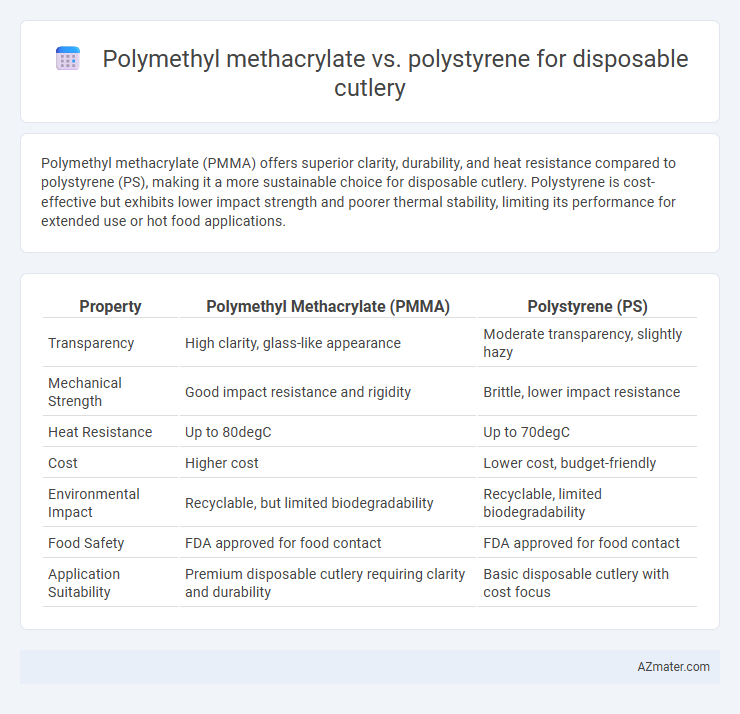Polymethyl methacrylate (PMMA) offers superior clarity, durability, and heat resistance compared to polystyrene (PS), making it a more sustainable choice for disposable cutlery. Polystyrene is cost-effective but exhibits lower impact strength and poorer thermal stability, limiting its performance for extended use or hot food applications.
Table of Comparison
| Property | Polymethyl Methacrylate (PMMA) | Polystyrene (PS) |
|---|---|---|
| Transparency | High clarity, glass-like appearance | Moderate transparency, slightly hazy |
| Mechanical Strength | Good impact resistance and rigidity | Brittle, lower impact resistance |
| Heat Resistance | Up to 80degC | Up to 70degC |
| Cost | Higher cost | Lower cost, budget-friendly |
| Environmental Impact | Recyclable, but limited biodegradability | Recyclable, limited biodegradability |
| Food Safety | FDA approved for food contact | FDA approved for food contact |
| Application Suitability | Premium disposable cutlery requiring clarity and durability | Basic disposable cutlery with cost focus |
Introduction to Disposable Cutlery Materials
Polymethyl methacrylate (PMMA) and polystyrene (PS) are prominent materials used for disposable cutlery due to their unique properties. PMMA offers superior clarity, chemical resistance, and durability, making it ideal for premium applications, while polystyrene is favored for its cost-effectiveness, ease of molding, and lightweight nature. The balance between mechanical strength, environmental impact, and manufacturing cost plays a crucial role in material selection for disposable utensils.
Overview of Polymethyl Methacrylate (PMMA)
Polymethyl Methacrylate (PMMA), a transparent thermoplastic, is widely used in disposable cutlery due to its excellent clarity, impact resistance, and weatherability compared to Polystyrene (PS). PMMA offers superior stiffness and durability, making it less prone to cracking or breaking under stress, which enhances the usability of disposable cutlery. Its high resistance to UV light and chemical degradation ensures that PMMA cutlery maintains shape and functionality throughout typical single-use scenarios.
Overview of Polystyrene (PS)
Polystyrene (PS) is a lightweight, rigid plastic commonly used in disposable cutlery due to its low cost and ease of molding into various shapes. It offers good clarity and a smooth surface, making it suitable for utensils, but it lacks the heat resistance and impact strength found in Polymethyl methacrylate (PMMA). PS is widely chosen for single-use applications where cost efficiency and mass production are critical factors.
Physical Properties Comparison: PMMA vs Polystyrene
Polymethyl methacrylate (PMMA) exhibits higher hardness and better scratch resistance compared to polystyrene, making it more durable for disposable cutlery applications. PMMA has superior clarity and UV resistance, ensuring cutlery remains transparent and less prone to yellowing over time. Polystyrene, while more cost-effective, is more brittle, with lower impact resistance and less chemical stability, limiting its durability for repeated use.
Durability and Strength Analysis
Polymethyl methacrylate (PMMA) offers superior durability with higher impact resistance and tensile strength compared to polystyrene, making it less prone to cracking or breaking under stress in disposable cutlery applications. Polystyrene, although more cost-effective, exhibits lower mechanical strength and brittleness, reducing its reliability during use. The enhanced structural integrity of PMMA ensures better performance in heavy-duty or prolonged use scenarios, prioritizing durability over cost.
Heat Resistance and Food Safety
Polymethyl methacrylate (PMMA) offers superior heat resistance compared to polystyrene, withstanding temperatures up to 160degC without deformation, making it more suitable for hot food applications. Polystyrene has a lower heat tolerance, typically softening around 100degC, which may lead to safety concerns when used with hot foods due to potential leaching of styrene monomers. In terms of food safety, PMMA is generally regarded as safer for direct contact with both hot and cold foods, whereas polystyrene has raised concerns over toxic substance migration at elevated temperatures.
Environmental Impact and Biodegradability
Polymethyl methacrylate (PMMA) and Polystyrene (PS) both serve as common materials for disposable cutlery, yet their environmental impact and biodegradability differ significantly. PMMA exhibits lower environmental toxicity and greater potential for recycling, whereas polystyrene's production and degradation release more pollutants and microplastics, contributing to persistent environmental contamination. Neither material biodegrades efficiently under natural conditions, but PMMA's chemical structure allows for better recycling opportunities, reducing long-term environmental burden compared to polystyrene's limited recyclability and high ecological footprint.
Cost Efficiency for Mass Production
Polymethyl methacrylate (PMMA) offers superior transparency and durability compared to polystyrene, but its higher material cost impacts overall expense for disposable cutlery. Polystyrene remains a more cost-efficient choice for mass production due to lower raw material costs and easier processing, enabling large-scale manufacturing with reduced expenses. Manufacturers prioritize polystyrene when balancing quality and budget constraints for disposable cutlery products.
Aesthetic and Design Possibilities
Polymethyl methacrylate (PMMA) offers superior clarity and gloss compared to polystyrene, providing a more visually appealing and premium finish for disposable cutlery. Its excellent transparency allows for vibrant color incorporation and intricate design customization, enhancing aesthetic versatility. Polystyrene, while cost-effective, typically exhibits a more opaque and brittle texture, limiting design complexity and color vibrancy in disposable utensils.
Conclusion: Choosing the Best Material for Disposable Cutlery
Polymethyl methacrylate (PMMA) offers superior clarity, higher impact resistance, and better thermal stability compared to polystyrene, making it more suitable for premium disposable cutlery applications requiring durability and aesthetic appeal. Polystyrene, while cost-effective and lightweight, has lower heat resistance and brittleness issues that limit its use in hot or demanding environments. Selecting PMMA ensures enhanced performance and user experience, justifying its higher cost for disposable cutlery intended for repeated or hot food usage.

Infographic: Polymethyl methacrylate vs Polystyrene for Disposable cutlery
 azmater.com
azmater.com